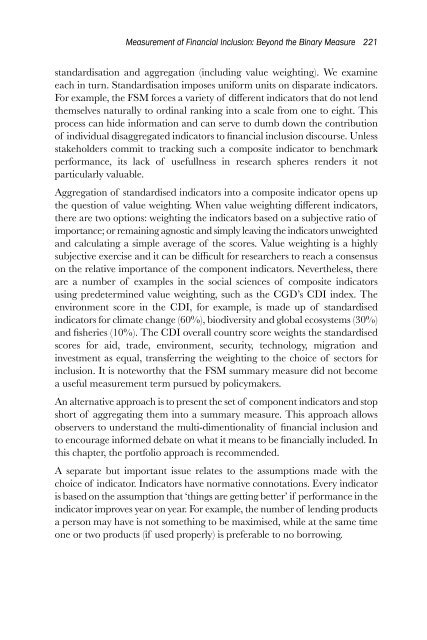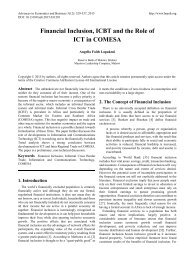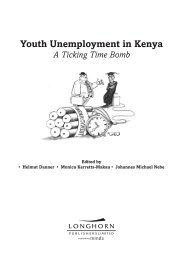in the 21st Century
hTOE305aYVW
hTOE305aYVW
Create successful ePaper yourself
Turn your PDF publications into a flip-book with our unique Google optimized e-Paper software.
Measurement of F<strong>in</strong>ancial Inclusion: Beyond <strong>the</strong> B<strong>in</strong>ary Measure 221<br />
standardisation and aggregation (<strong>in</strong>clud<strong>in</strong>g value weight<strong>in</strong>g). We exam<strong>in</strong>e<br />
each <strong>in</strong> turn. Standardisation imposes uniform units on disparate <strong>in</strong>dicators.<br />
For example, <strong>the</strong> FSM forces a variety of different <strong>in</strong>dicators that do not lend<br />
<strong>the</strong>mselves naturally to ord<strong>in</strong>al rank<strong>in</strong>g <strong>in</strong>to a scale from one to eight. This<br />
process can hide <strong>in</strong>formation and can serve to dumb down <strong>the</strong> contribution<br />
of <strong>in</strong>dividual disaggregated <strong>in</strong>dicators to f<strong>in</strong>ancial <strong>in</strong>clusion discourse. Unless<br />
stakeholders commit to track<strong>in</strong>g such a composite <strong>in</strong>dicator to benchmark<br />
performance, its lack of usefullness <strong>in</strong> research spheres renders it not<br />
particularly valuable.<br />
Aggregation of standardised <strong>in</strong>dicators <strong>in</strong>to a composite <strong>in</strong>dicator opens up<br />
<strong>the</strong> question of value weight<strong>in</strong>g. When value weight<strong>in</strong>g different <strong>in</strong>dicators,<br />
<strong>the</strong>re are two options: weight<strong>in</strong>g <strong>the</strong> <strong>in</strong>dicators based on a subjective ratio of<br />
importance; or rema<strong>in</strong><strong>in</strong>g agnostic and simply leav<strong>in</strong>g <strong>the</strong> <strong>in</strong>dicators unweighted<br />
and calculat<strong>in</strong>g a simple average of <strong>the</strong> scores. Value weight<strong>in</strong>g is a highly<br />
subjective exercise and it can be difficult for researchers to reach a consensus<br />
on <strong>the</strong> relative importance of <strong>the</strong> component <strong>in</strong>dicators. Never<strong>the</strong>less, <strong>the</strong>re<br />
are a number of examples <strong>in</strong> <strong>the</strong> social sciences of composite <strong>in</strong>dicators<br />
us<strong>in</strong>g predeterm<strong>in</strong>ed value weight<strong>in</strong>g, such as <strong>the</strong> CGD’s CDI <strong>in</strong>dex. The<br />
environment score <strong>in</strong> <strong>the</strong> CDI, for example, is made up of standardised<br />
<strong>in</strong>dicators for climate change (60%), biodiversity and global ecosystems (30%)<br />
and fisheries (10%). The CDI overall country score weights <strong>the</strong> standardised<br />
scores for aid, trade, environment, security, technology, migration and<br />
<strong>in</strong>vestment as equal, transferr<strong>in</strong>g <strong>the</strong> weight<strong>in</strong>g to <strong>the</strong> choice of sectors for<br />
<strong>in</strong>clusion. It is noteworthy that <strong>the</strong> FSM summary measure did not become<br />
a useful measurement term pursued by policymakers.<br />
An alternative approach is to present <strong>the</strong> set of component <strong>in</strong>dicators and stop<br />
short of aggregat<strong>in</strong>g <strong>the</strong>m <strong>in</strong>to a summary measure. This approach allows<br />
observers to understand <strong>the</strong> multi-dimentionality of f<strong>in</strong>ancial <strong>in</strong>clusion and<br />
to encourage <strong>in</strong>formed debate on what it means to be f<strong>in</strong>ancially <strong>in</strong>cluded. In<br />
this chapter, <strong>the</strong> portfolio approach is recommended.<br />
A separate but important issue relates to <strong>the</strong> assumptions made with <strong>the</strong><br />
choice of <strong>in</strong>dicator. Indicators have normative connotations. Every <strong>in</strong>dicator<br />
is based on <strong>the</strong> assumption that ‘th<strong>in</strong>gs are gett<strong>in</strong>g better’ if performance <strong>in</strong> <strong>the</strong><br />
<strong>in</strong>dicator improves year on year. For example, <strong>the</strong> number of lend<strong>in</strong>g products<br />
a person may have is not someth<strong>in</strong>g to be maximised, while at <strong>the</strong> same time<br />
one or two products (if used properly) is preferable to no borrow<strong>in</strong>g.














